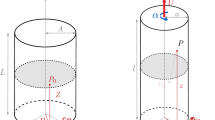Abstract
The failure behaviour in static fatigue of thermoplastic elastomers was estimated on the basis of the stochastic theory proposed for the failure of rubber vulcanizates. A statistical analysis of lifetime distributions for a styrene-butadiene-styrene triblock copolymer (SBS) in creep and stress relaxation experiments was made by using a Weibull distribution, and the failure behaviour of SBS was related to morphological changes of structure in stretched states, observed with a transmission electron microscope. Wear-out failure, in which the failure rate increases with time, occurs in the creep and stress-relaxation processes, and is similar to that in a carbon-reinforced rubber vulcanizate. These results suggest that in SBS, polystyrene (PS) domains dispersed in a continuous polybutadiene matrix serve as physical crosslinks and reinforcing fillers. In the stress relaxation process, however, the increased energy dissipation caused by plastic deformation and disruption of the PS domains leads the material to be more stabilized at a constant stretch ratio. This prolongs the lifetime of the material, due to multi-crack initiation at many portions of a specimen. The differences between the failure behaviour of SBS and that of the rubber vulcanizates are mainly caused by morphological changes of the structure in SBS on deformation.
Similar content being viewed by others
References
G. Holden, E. T. Bishop andN. R. Legge,J. Polym. Sci. Part C 26 (1969) 37.
J. A. Manson andL. H. Sperling, “Polymer Blends and Composites” (Plenum Press, New York, 1976) p. 121.
M. Morton,J. Polym. Sci. Symposium No. 60 (1977) 1.
J. C. West andS. L. Cooper, in “Science and Technology of Rubber” edited by F. R. Eirich, (Academic Press, New York, 1978) p. 531.
M. Shen andH. Kawai,Amer. Inst. Chem. Engrs. J. 24 (1978) 1.
D. M. Brunwin, E. Fischer andJ. F. Henderson,J. Polymer Sci. Part C 26 (1969) 135.
D. G. Fesko andN. W. Tschoegl,ibid. 35 (1971) 51.
D. H. Kaelble,Trans. Soc. Rheol. 15 (1971) 235.
D. H. Kaelble andE. H. Cirlin,J. Polym. Sci. Symposium No. 43 (1973) 131.
M. Shen andV. A. Kaniskin,J. Polym. Sci. Polym. Phys. Ed. 11 (1973) 2261.
J. A. Odell andA. Keller,Polym. Eng. Sci. 17 (1977) 544.
J. F. Beecher, L. Marker, R. D. Bradford andS. L. Aggarwal,J. Polym. Sci. Part C 26 (1969) 117.
T. L. Smith andR. A. Dickie,ibid. 26 (1969) 163.
T. L. Smith, in “Block Polymers”, edited by S. L. Aggarwal (Plenum Press, New York, 1970) p. 137.
Idem, J. Polym. Sci., Polym. Phys. Ed. 12 (1974) 1825.
T. Inoue, M. Moritani, T. Hashimoto andH. Kawai,Macromolecules 4 (1971) 500.
S. Kawabata, in “Durability of Macromolecular Materials”, edited by R. K. Eby, ACS Symposium Series 95 (American Chemical Society, Washington, D. C., 1979) p. 261.
K. Fukumori andT. Kurauchi,J. Mater. Sci. 19 (1984) 2501.
W. Weibull, “Fatigue Testing and Analysis of Results” (Pergamon Press, New York, 1961) p. 143.
J. H. K. Kao,J. Amer. Statis. Assoc. 51 (1956) 514.
Author information
Authors and Affiliations
Rights and permissions
About this article
Cite this article
Fukumori, K., Kurauchi, T. Static fatigue of thermoplastic elastomers. J Mater Sci 20, 1725–1732 (1985). https://doi.org/10.1007/BF00555277
Received:
Accepted:
Issue Date:
DOI: https://doi.org/10.1007/BF00555277




